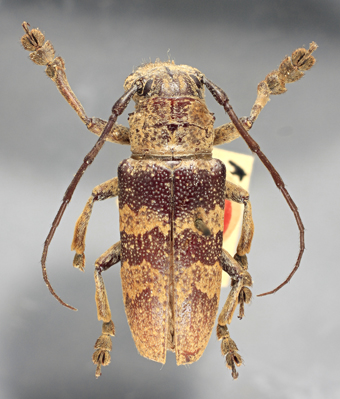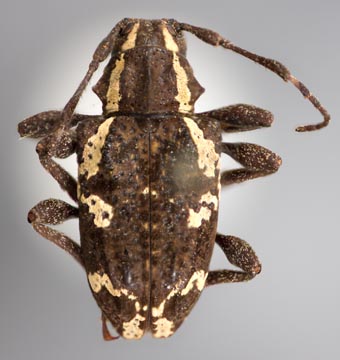 |
Cerambycidae
Classification
Introduction
- The family Cerambycidae Latreille, 1802 currently contains ~40,000 described species in 4,000 genera and 8 subfamilies. Photographs of 235 exemplar specimens are currently available for this family. This diverse and economically important group of insects are commonly referred to as longhorned beetles and comprise one of the largest beetle families.
Diagnostic Features of Adults
- The long antennae, absence of a beak, and characteristic tarsi serve to separate most adults of this very large family from other beetles (Turnbow & Thomas, 2002).
- Length 1.9-175 mm. Antenna 11-segmented, occasionally with fewer than 11 segments, rarely with 12 or more segments, filiform, serrate, pectinate, flabellate, clavate, or rarely with 1- to 2-segmented club. Antennal insertions exposed or rarely concealed. Prosternal process complete, incomplete or absent. Procoxal cavities strongly transverse to circular, externally open or closed, internally open or closed. Mesocoxal cavities contiguous to very widely separated, laterally open or closed. Tarsi pseudotetramerous or rarely 5-5-5. Abdomen with 5 free ventrites. Highly variable but usually elongate with very long antennae and raised antennal insertions. Body surfaces glabrous or clothed with hairs or scales (Lawrence, 2007).
Diagnostic Features of Larvae
- Larva. Form rather robust, fleshy, usually more or less cylindrical. Integument thin, slightly coriaceous, more so on prothorax; never deeply pigmented nor chitinized; very pubescent or hairy. Head extensible; occiput large; occipital foramen very large, opening on underside. Ventral surface of head bridged by the broad hypostoma; gula short, lying on top of the hypostoma; anterior edge of hypostoma scarcely retracted relative to the ventral articulation of the mandible. Ventral mouth-parts compact, not retracted; maxillary stipes not free (movable only in one plane); maxillary sclerite distinct, often cushioned. Clypeus and labrum distinct. Mandibles short, quadrangular, no molar part. Prothorax large, membranous; collar articulating head with prothorax wide. No hypopleural chitizination on thorax. Legs either small or wanting, widely distant, conical, tarsus claw-shaped. Abdomen extended, segments readily telescoping on one another, dorsally and ventrally bearing fleshy ambulatory ampullae. Spiracles bilabiate, the two-lipped respiratory opening narrow; lips membranous, clothed with setiferous tubercles. Cerci absent, or chitinous unjointed processes. Anal lobes three (rarely two), exserted, terminal. Adapted from Craighead (1923).
Geographic Distribution of Family
Biology and Economic Importance
- Larvae of most species develop for about one year in the trunk or branch wood of living or dead trees (although some species can have two broods per year and other species may take five years or more for maturation). Larvae of some species develop in highly decomposed wood, while others develop in herbaceous plants or roots. A few notorious species can infest and kill otherwise healthy trees and can have a major economic impact. Adults are relatively short lived, probably most living less than 1 month. Many do little or no feeding as adults, although in some groups they actively feed on pollen and nectar of flowers or are attracted to sap flows on trees (summarized from Linsley, 1961; Lawrence, 2007; and other sources).
Selected References to Adult Specimens
Selected References to Larvae Specimens
|  |

Abryna rubeta
Pascoe, 1864; dorsal
holotype specimen
Cerambycidae
Photograph © E.H. Nearns

Acakyra laterialba
Martins & Galileo, 2001; dorsal
holotype specimen
Cerambycidae
Photograph © E.H. Nearns

Acalolepta dispar
(Pascoe, 1866); dorsal
syntype specimen
Cerambycidae
Photograph © E.H. Nearns
|




